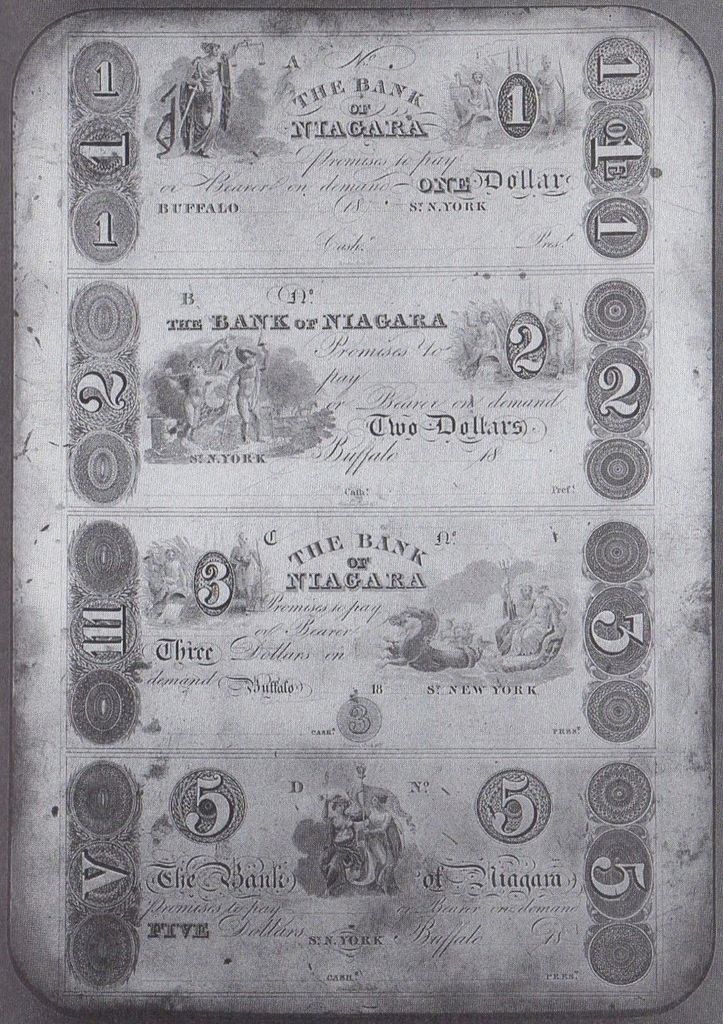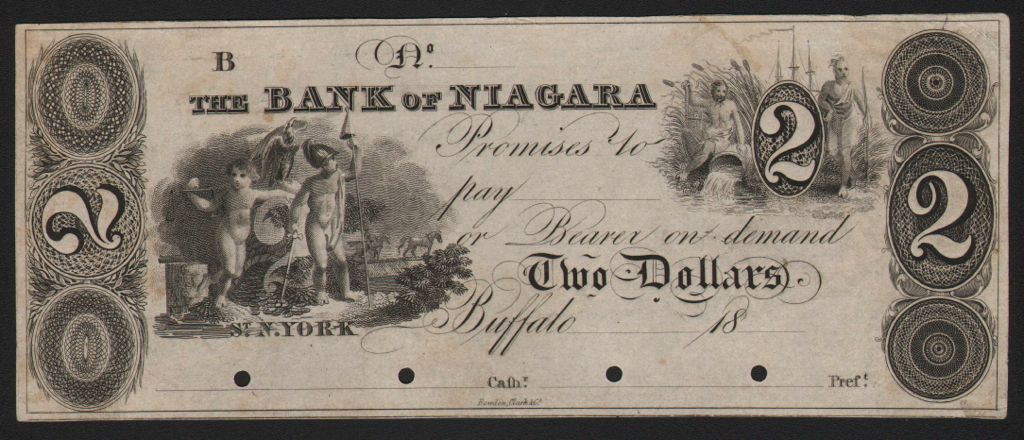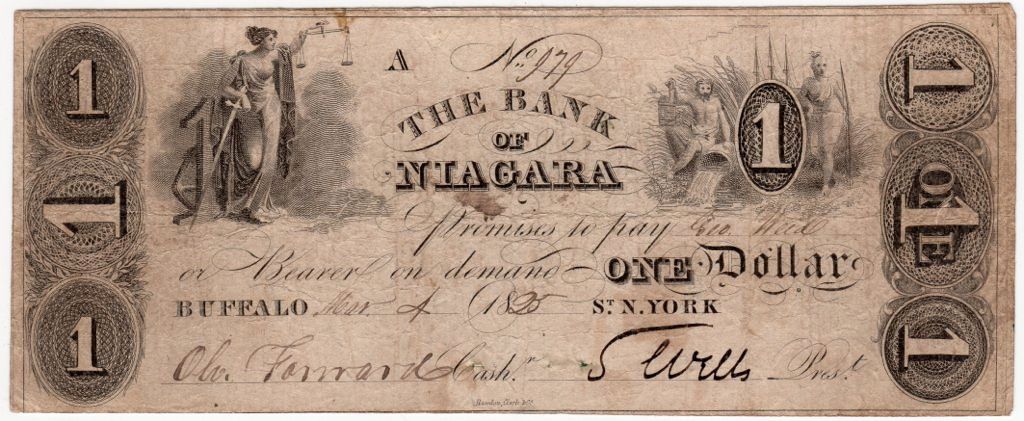Bank of Niagara printing plate.
I was rereading a book entitled Rise and Fall of a Frontier Entrepreneur: Benjamin Rathbun, Master Builder and Architect. If you collect obsoletes, then you have probably seen unredeemed scrip from Buffalo by him. He basically built Buffalo and then came the crash of 1836-7 that totally ruined him and sent him to jail. Here is a cool youtube movie abut him.
Anyway, I found an image in the book of a printing plate of the 1820's from The Bank of Niagara in Buffalo:

Russell (sellitstore) had shown me an image of a $2 proof from this plate a few years back. This note is listed in Haxby, NY-460-G44, as a proof. Russell's note actually looks like the Haxby plate note. It very probably is unique.

I had previously obtained a Haxby unlisted $1 that looked similar to Russell's $2 note.

So the $1 and the $2 are both from this plate. I have never seen any version of the $3 and $5 notes. Has anyone else seen other copies from this plate?
This is a relatively early plate (~1820's) printed by Rawdon, Clark & Co., Albany. Note that the plate letters are numbered A-B-C-D even though the notes are $1-2-3-5. Does this indicate anything????
Any help is appreciated.
Anyway, I found an image in the book of a printing plate of the 1820's from The Bank of Niagara in Buffalo:

Russell (sellitstore) had shown me an image of a $2 proof from this plate a few years back. This note is listed in Haxby, NY-460-G44, as a proof. Russell's note actually looks like the Haxby plate note. It very probably is unique.

I had previously obtained a Haxby unlisted $1 that looked similar to Russell's $2 note.

So the $1 and the $2 are both from this plate. I have never seen any version of the $3 and $5 notes. Has anyone else seen other copies from this plate?
This is a relatively early plate (~1820's) printed by Rawdon, Clark & Co., Albany. Note that the plate letters are numbered A-B-C-D even though the notes are $1-2-3-5. Does this indicate anything????
Any help is appreciated.

Bernie
Always looking for material from the Niagara river region.
0
Comments
Shouldn't the plate be "backwards" ? or has it be photoshopped to be right reading ?
It is flipped for comparison to the notes.
Bernie
Always looking for material from the Niagara river region.
Montani Semper Liberi (Mountaineers are always free)
A-B-C-D are the plate positions. Had the sheet been notes of $1, $5, $10, and $20 the letters would still be A-B-C-D.
Actually a 1A-5B-10C-20D plate would be extremely unusual. It would typically be 1A-5A-10A-20A because the plate letters would typically start over from A for a different denomination.
Below are sheets for 5A-5B-5C-5D; 20A-50A-100A-500A; 1A-1B-2A-5A; 10B-20A-50A-100A. So why does the last sheet start with 10B and not 10A?
All images from the Heritage archives.
Bernie
Always looking for material from the Niagara river region.
A-B-C-D are the plate positions. Had the sheet been notes of $1, $5, $10, and $20 the letters would still be A-B-C-D.
Actually a 1A-5B-10C-20D plate would be extremely unusual. It would typically be 1A-5A-10A-20A because the plate letters would typically start over from A for a different denomination.
Below are sheets for 5A-5B-5C-5D; 20A-50A-100A-500A; 1A-1B-2A-5A; 10B-20A-50A-100A. So why does the last sheet start with 10B and not 10A?
+1
Indeed, the 1A-5A-10A-20A assignment is the same used for NBNs. I've not really thought about it before, but the sheet in the OP is quite early so it appears that the convention for assigning plate letters was still not agreed to by all of the printers. Certainly a bank with a lot of plates could run out of letters quickly under that approach.
On the 10B, the use of the B suggests that an A position $10 was used previously in a different sheet layout (perhaps lower denominations).
Interesting!
edited to add: the city name seems to have been entertainingly misspelled on the TPG label...
Yes, there is a 5A-5B-5C-10A plate.
Bernie
Always looking for material from the Niagara river region.